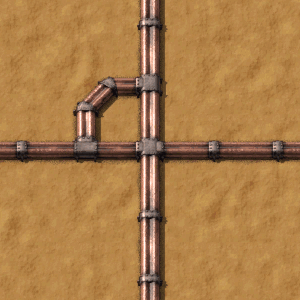Heat pipe: Difference between revisions
m →History: add to history |
No edit summary |
||
| Line 7: | Line 7: | ||
As heat pipes rise in temperature, they will give off a very low-distance glow. | As heat pipes rise in temperature, they will give off a very low-distance glow. | ||
== Heat pipe throughput == | |||
Heat pipes are acting very similarly to fluid [[pipe]]s: they each hold an amount of heat energy and there is a limit to how much of that energy can go through each of them. | |||
For any given heat pipe entity with one input connection on one side and one output connection on another, this entity with lower the temperature by <code>1 + (P / 15) °C</code> with P being the power going through this entity expressed in MW. | |||
Since a nuclear power plants can have at most 500°C difference between the hottest (a [[nuclear reactor]]) and coldest (a [[heat exchanger]]) point of the system, that means that we can express the maximum length of a straight line of heat pipe as <code>500 / (1 + P/15)</code>. | |||
For example let's take a single [[nuclear reactor]] outputting 40MW of heat power to a single line of heat pipes. The furthest that line can go is <code>500 / (40/15 + 1)</code> which is around 136 heat pipes long. | |||
== History == | == History == | ||
Revision as of 20:31, 14 September 2022
| Heat pipe |
- Base game
- Space Age mod
The heat pipe can transport heat over longer distances and connect devices which produce and use heat. Currently this is limited to heat exchangers and nuclear reactors.
Heat pipes have a heat capacity of 1 MJ/°C. Thus, they can theoretically buffer 500 MJ of heat energy across their working range of 500°C to 1000°C, making them a space-efficient energy store. However, because temperature needs a drop of greater than 1 degree before it will "flow," you can't raise them all the way to 1000°C or drain them all the way to 500°C, so the practical energy capacity will depend on the layout.
As heat pipes rise in temperature, they will give off a very low-distance glow.
Heat pipe throughput
Heat pipes are acting very similarly to fluid pipes: they each hold an amount of heat energy and there is a limit to how much of that energy can go through each of them.
For any given heat pipe entity with one input connection on one side and one output connection on another, this entity with lower the temperature by 1 + (P / 15) °C with P being the power going through this entity expressed in MW.
Since a nuclear power plants can have at most 500°C difference between the hottest (a nuclear reactor) and coldest (a heat exchanger) point of the system, that means that we can express the maximum length of a straight line of heat pipe as 500 / (1 + P/15).
For example let's take a single nuclear reactor outputting 40MW of heat power to a single line of heat pipes. The furthest that line can go is 500 / (40/15 + 1) which is around 136 heat pipes long.
History
- 0.17.67:
- Heat pipes (also in reactors and heat exchangers) glow with high temperatures.
- 0.15.11:
- Changed heat transfer mechanics, prior to this heat would flow better following the order of heat pipe placement
- 0.15.0:
- Introduced
See also
